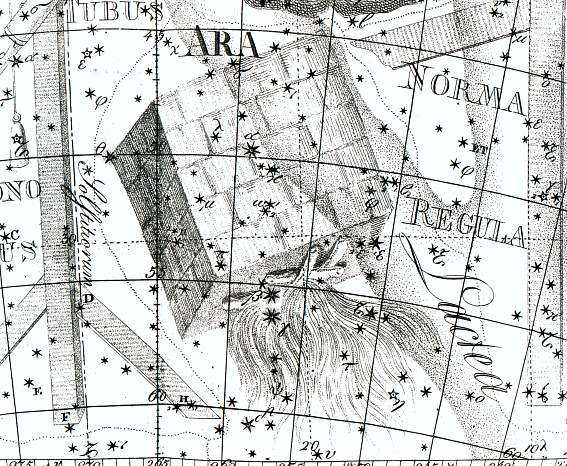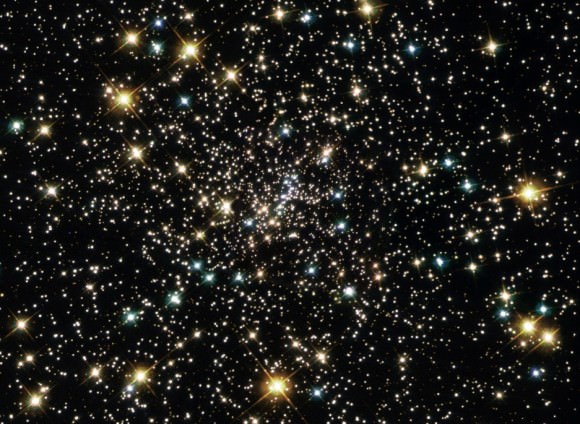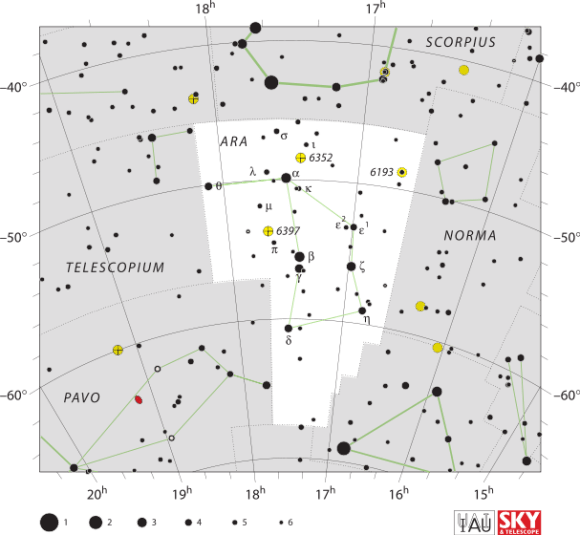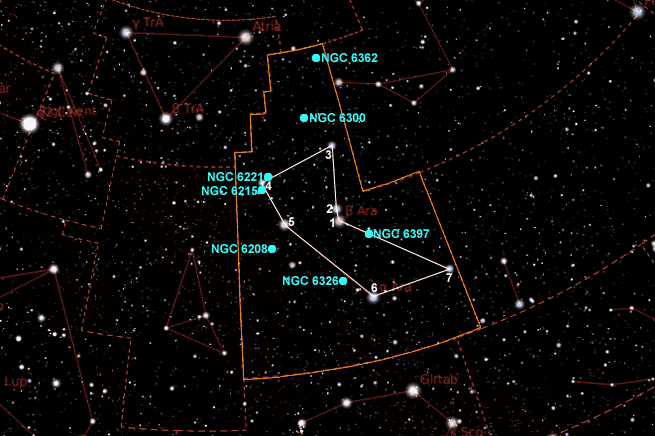Welcome back to another Constellation Friday, another series dedicated to the memory of the late, great Tammy Plotner. And today, we take a look at Ara, one of the classic southern constellation.
In the 2nd century CE, Greek-Egyptian astronomer Claudius Ptolemaeus (aka. Ptolemy) released one of the most influential books in the history of astronomy. Known as the Almagest, this book included the 48 then-known constellation into a system of cosmology that would remain influential for over a thousand years. Among the 48 constellations listed in this book was Ara, a constellation in the southern sky that is crossed by the Milky Way.
Also known as “The Altar”, Ara is best visible the month of July in the southern hemisphere (latitudes between +25° and -90°). It is bordered by Corona Australis, Scorpius, Norma, Triangulum Australe, Apus, Pavo and Telescopium, and its primary stars form a notable asterism which seems to represent the figure H. Ara belongs to the Hercules family of constellations, together with Aquila, Centaurus, Corona Australis, Corvus, Crater, Crux, Cygnus, Hercules, Hydra, Lupus, Lyra, Ophiuchus, Sagitta, Scutum, Serpens, Sextans, Triangulum Australe, and Vulpecula.
Name and Meaning:
In Greek mythology, Ara represented the altar used by Zeus and other Greek gods to swear a vow of allegiance before they went to war against Cronus and the Titans. According to legends, it is believed the Cyclopes originally built the altar as a place to sacrifice to the Olympian gods. It was also upon this altar that Centaurus the centaur sacrificed Lupus the wolf.

The altar was normally depicted as upside down, but sometimes it was shown as erect with the smoke drifting away as the Milky Way. Some legends have it that a child was once sacrificed, whereupon Zeus then turned the child into a wolf and immortalized it in stars forming the constellation of Lupus. In another Greek myth, Ara represents the altar of King Lycaon of Arcadia.
Notable Features:
Since Ara contains part of the Milky Way to the south of Scorpius, it therefore has rich star fields. Its major stars include Alpha Arae, a blue-white hued star of magnitude 2.8 that is the closest of Ara’s stars, located approximately 242 light-years from Earth. Beta Arae, its brightest star, is an orange-hued supergiant of magnitude 2.8, which is located 600 light-years from Earth.
Gamma Arae is a blue-hued supergiant of magnitude 3.3, located 1140 light-years from Earth, while Delta Arae has a blue-white hue, a magnitude of 3.6, and is located 187 light-years from Earth. Zeta Ara is an orange-hued giant of magnitude 3.1, and is located 574 light-years from Earth. Ara is also home to several Deep Sky Objects.
For instance, the northwest corner of Ara is crossed by the galactic plane of the Milky Way, and therefore contains several open clusters and diffuse nebulae. For instance, there is the NGC 6397 globular cluster, which is the brightest in the Ara constellation. It is also one of the closest to our Solar System, being 6,500 light-years from Earth.

Ara also contains Westerlund 1, a super star cluster that contains the red supergiant Westerlund 1-26, one of the largest stars known. Ara is also home to two spiral galaxies – NGC 6215 and NGC 6221 – which are visible near the star Eta Arae.
History of Observation:
Ara was first described by Ptolemy and was included in the 48 constellations listed in the Almagest. Today, it is one of the 88 constellations that is recognized by the International Astronomical Union (IAU).
Finding Ara:
For those using binoculars,Ara can be located by looking for Beta Arae, the brightest star of the constellation. Beta is an orange class K (K3) supergiant with a luminosity of about 4600 times that of the Sun. It also rotates on its axis at about 5.4 kilometers per second at it equator, it takes around 2.33 years for Beta to make a full rotation. As a result, any sunspots on Beta would be visible for a very long time! Beta is also an unusual “super metal-rich” star, with high iron content, over three times more than that of Sol.
Then there’s a Alpha Arae, a spectroscopic binary that is a hot, blue, luminous class B (B2) dwarf star. Just because it’s called a dwarf doesn’t mean it’s small, though. Alpha is still about 8 times the mass of our own Sun. It’s a very special star, too. It’s known as “Be” (B-emission”) star, who’s emission lines come from from hydrogen located in a thick disk that surrounds it. Alpha is a “shell star” and the disk is nearly edge on, obscuring part of the star, and superimposing absorptions on the star’s spectrum.

Now move on to R Arae – a variable star. Its magnitude ranges from 6 to 7.1 in a period of 4.4 days. R Arae or HD 149730 is eclipsing binary of Algol type and well worth watching for its quick changes!
Need a little more sparkle in your binoculars? Then head on to NGC 6193. At a distance of only 7200 light years away, it’s one of the nearest globular clusters to our solar system and on a clear dark night, it can even be seen with the unaided eye! Binoculars or a small telescope show it as a misty patch with a diameter close to 20 arc minutes. Or try open cluster NGC 6193 located eight degrees west of Alpha Arae. This widely scattered group will show about 30 stars, the brightest of which is about 6th magnitude.
For telescopes, the binary star Gamma Arae offers a great opportunity for stargazing. Located 1140 light years from Earth, this 3.5 and 10th magnitude pair is separated by 18 arc seconds and was found to be binary by John Herschel in 1835. The primary component, Gamma Arae A, is a blue-white B-type supergiant and the companion Gamma Arae B, is a white A-type main sequence dwarf star.
Now locate 4th magnitude Epsilon1 Arae and go 1.5 degrees west for NGC 6208. This 7.5 combined magnitude open cluster presents a nice challenge for the telescope! Three new spectroscopic binaries were discovered recently among the red giants of NGC 6208. It contains about 60 stars and the brightest is about magnitude 10.
We have written many interesting articles about the constellation here at Universe Today. Here is What Are The Constellations?, What Is The Zodiac?, and Zodiac Signs And Their Dates.
Be sure to check out The Messier Catalog while you’re at it!
For more information, check out the IAUs list of Constellations. and the Students for the Exploration and Development of Space page on Ara and Constellation Families.


We’re at 38.5*N too high to see much of the constellation Ara most of the year. But maybe on a clear night with good conditions? Elevation is key. Best to travel up into the local mountains for deep sky views, to get above the marine layer above 1,500 feet… or so.